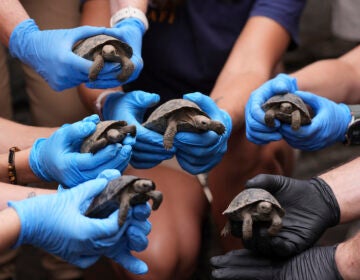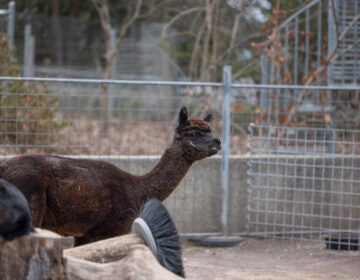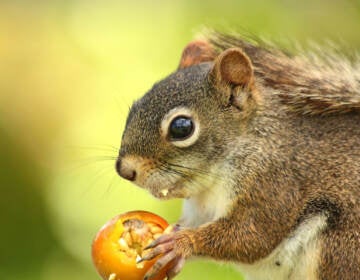Cracking the code of animal attraction is more than pretty feathers or mood lighting
Zoo curators often go the extra mile to make creatures feel at home under human care. But recreating romance in captivity still involves a lot of guesswork.
Listen 8:03
Keeper Andrew Ahl coaxes Mommy out of her shell. At 99, Mommy is the Philadelphia Zoo's senior Galapagos tortoise. Recent attempts to mate her resulted in three clutches of eggs, but none were viable. (Emma Lee/WHYY)
This story is from The Pulse, a weekly health and science podcast.
Find it on Apple Podcasts, Spotify, or wherever you get your podcasts.
In the months following the release of his ground-breaking theory of natural selection, “On The Origin of Species,” Charles Darwin lamented the existence of an animal that flamboyantly challenged his thesis.
“The sight of a feather in a peacock’s tail, whenever I gaze at it, makes me sick!” Darwin wrote in a letter to botanist Asa Gray.
The giant feathers lugged around by male peacocks called into question the most basic assumptions of his theory that, over the course of generations, species change and evolve in ways that favor their survival.
The tail was like a heavy, colorful target on their backs.
“If anything, these traits should decrease survivorship, not increase it,” said Michael Ryan, a professor of integrative biology at the University of Texas at Austin and a senior research associate at the Smithsonian Tropical Research Institute in Panama.
In “A Taste for the Beautiful: The Evolution of Attraction,” Ryan traces how similar contradictions in natural phenomena led Darwin to believe another parallel force must be at play, too – not just natural selection, but also sexual selection.
“Natural selection favors traits that enhance survivorship,” said Ryan. “Sexual selection favors traits that enhance an individual’s ability to acquire mates.”
For Darwin, this distinction explained why so many other males across the animal kingdom possess seemingly useless characteristics and abilities.
Generally speaking, because females often produce far fewer eggs than males produce sperm, so females have to be more choosy about their partners.
Over time, these traits increasingly conform to female preferences, sometimes even when they fly in the face of natural selection.
Subscribe to The Pulse
Unlike natural selection, which was embraced by Darwin’s contemporaries, sexual selection’s intersection with female preference took about a century to come into vogue.
“Darwin was a Victorian, and he was operating in a Victorian society,” Ryan said. “And there was no way that Victorian gentlemen were willing to grant to females, even female animals, the power to decide who mates.”
Today, the idea is a widely accepted tenet of evolutionary theory.
But Ryan wanted to figure out what fuels preference in the first place by studying the mating call of the Túngara frog, a small wart-covered species found in Panama.
The mating calls of male Túngara frogs offered a unique opportunity.
“All of these males, they make a whine. And all of these males can add to that whine a chuck,” he said.
Some males added multiple chucks to the end of their calls. Others added none at all.
What kind of calls did female Túngara frogs prefer?
To find out, Ryan placed female Túngara frogs in between two speakers – one that only played whine sounds and another that played whines with a chuck.
“Eighty-five percent of the time, they prefer the whine-chuck,” Ryan said.
Brain scans revealed neural excitement whenever the chuck played. Ryan explained the sound was triggering some deep unknown evolutionary response in the female frogs.
Soon he discovered it was possible to enhance this response using artificial methods, adding white noise and increasing the number of chucks. Male frogs were physically unable to imitate white noise to increase their likelihood of mating, but they were capable of adding more chucks.
So why weren’t they?
“If the chucks make the male more attractive, and if he’s out there to attract mates. Why doesn’t he always make chucks?” He asked.. “We’ve measured the energy they use … energetically, it doesn’t cost anything.”
Ryan was stumped. Then one day, a fellow researcher in Panama who studied bats mentioned that he had seen a bat with a Túngara frog in its mouth.
So he brought one of those bats into his mating-call sound chamber.
“We play them a whine from one speaker, a whine chuck from another speaker, they fly directly to the whine chuck, sometimes even landing on the speaker [like they were] trying to get to the frog inside.”
Male frogs have to walk a delicate line of making just enough extra noise to attract a mate without becoming dinner.
The revelation was years in the making and highlights just how unpredictable mate selection can be in the wild.
Creating ‘the mood’ in captivity
As the curator for reptiles and amphibians at the Philadelphia Zoo, it’s Lauren Augustine’s job to simulate all the factors that enable her creatures to proliferate in nature.
“We need to account for all of these different behaviors and their social dynamics. A lot goes into creating just one habitat here at the reptile house, and we have over 50,” said Augustine. “Reptiles and amphibians use a lot of chemical cues that obviously are really hard for us to interpret or understand.”
Even subtle changes to barometric pressure due to local rainstorms can trigger breeding inside animal enclosures.
It’s important to learn from these successes. Studies show animals born in captivity are far less likely to successfully reproduce than those born in the wild. So Augustine is constantly making adjustments to her habitats, trying to spark something in her cold-blooded animals.
She once spent three years trying to get one species of frog from Madagascar to mate.
“I built an enclosure that was basically individual 10 gallon tanks filled with sphagnum and cocoa shell mixed together so each frog could burrow in its cage. And then they had PVC tubes that connected to a big middle tank, right? And then I warmed them up and I rained on them and flooded their individual enclosures so that they would come up and then meet in the middle to try to create an explosive breeding situation.”
But still, the frogs just weren’t that into each other. Her efforts failed.
Some of the animals Augustine cares for are endangered – their genetic partners carefully chosen from a national studbook, then shipped in from other zoos across the country as part of global Species Survival Plans.
The practice is controversial, but if it is to ever be effective, getting endangered animals to breed is crucial to preserving millions of years of evolution.
“We have a pair of Galapagos tortoises here that are a recommended breeding pair. And so last spring we introduced, the male to the females. And sure enough we did get three clutches of eggs this year from our 99-year-old Galapagos tortoise female mommy — which is fantastic,” Augustine said.
The eggs never developed into hatchlings. But it was a promising result from a difficult equation, she said. Especially because, unlike other kinds of species, mate preference is typically not considered when trying to mate reptiles and amphibians.
“Just because they’re genetically a pair doesn’t mean that he’s gonna like her, it doesn’t mean that she’s gonna like him. And that they are compatible. We don’t really give them that option. It’s kind of infrequent with reptiles and amphibians right now.” said Augustine. “So we don’t really look at those pheromones and preference.”
The Philadelphia Zoo recently did score a win in kindling attraction with Chester, a spirited Francois Langur. Michael Stern, curator of primates and small mammals, describes Chester business-like.
“He’s a little bit standoffish. He kind of does his thing as a male. He surveys around and, and watches what’s going on and protects his family. But as soon as he saw these young females moving in with him of the same species, he knew exactly what to do, ” Stern said.
And, the result?
“These were the first Francois Langers born here at Philadelphia Zoo in our 150-year history,” Stern said.
WHYY is your source for fact-based, in-depth journalism and information. As a nonprofit organization, we rely on financial support from readers like you. Please give today.







